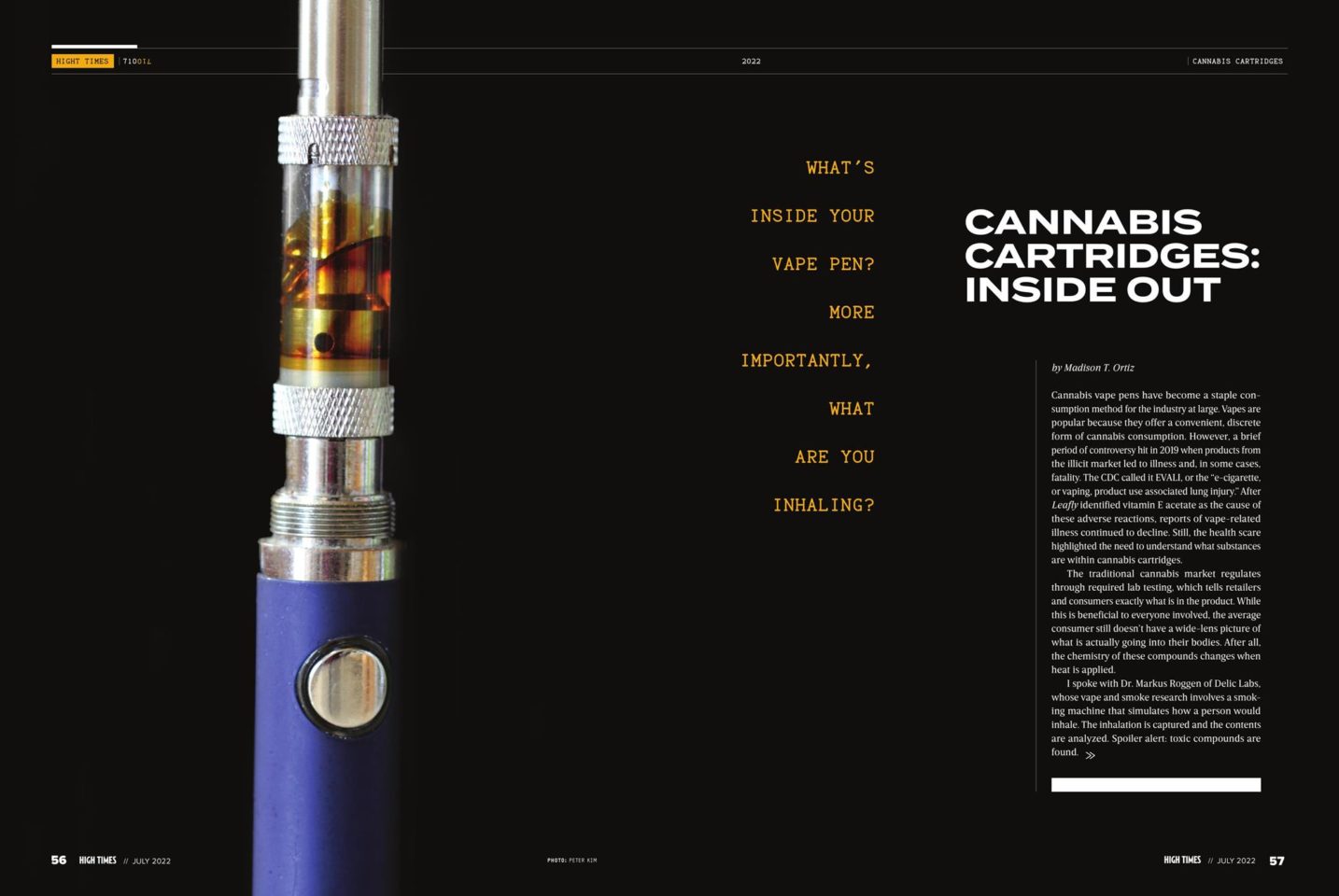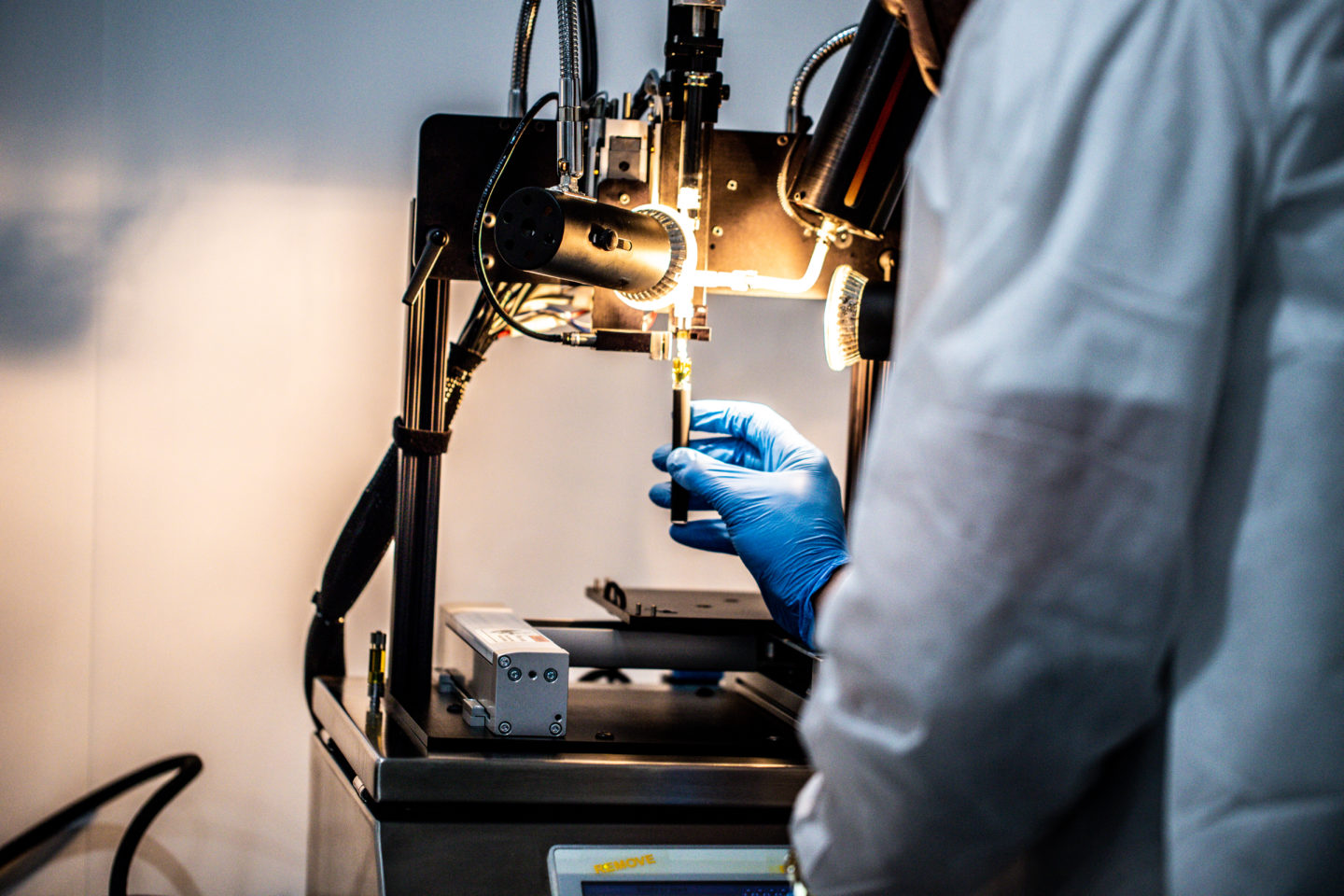Cannabis vape pens have become a staple consumption method for the industry at large. Vapes are popular because they offer a convenient, discrete form of cannabis consumption. However, a brief period of controversy hit in 2019 when products from the illicit market led to illness and, in some cases, fatality. The CDC called it EVALI, or the “e-cigarette, or vaping, product use associated lung injury.” After Leafly identified vitamin E acetate as the cause of these adverse reactions, reports of vape-related illness continued to decline. Still, the health scare highlighted the need to understand what substances are within cannabis cartridges.
The traditional cannabis market regulates through required lab testing, which tells retailers and consumers exactly what is in the product. While this is beneficial to everyone involved, the average consumer still doesn’t have a wide-lens picture of what is actually going into their bodies. After all, the chemistry of these compounds changes when heat is applied.
I spoke with Dr. Markus Roggen of Delic Labs, whose vape and smoke research involves a smoking machine that simulates how a person would inhale. The inhalation is captured and the contents are analyzed. Spoiler alert: toxic compounds are found.

What’s Inside Cartridges?
The short answer is cannabinoids, terpenes, flavonoids, and potentially some cutting agents.
Cannabinoids are unique compounds found in the cannabis plant that interact with the endocannabinoid system. The more infamous of these compounds include THC and CBD. Synthetic cannabinoids will be distinguishable on a lab test. However, those who consume products that haven’t been processed by the standards of the traditional market are at risk of inhaling these potentially unsafe compounds that are intended to mimic cannabinoids.
Terpenes are aroma and flavor compounds found in plants. Some commonly known terpenes are myrcene, limonene, and linalool. The terpenes present in your vape cartridge are either cannabis-derived, plant or fruit-derived, or synthetic. Differentiation on the label isn’t currently required, but most products with cannabis-derived terpenes will declare as such. Cartridges with naturally present cannabis-derived terpenes may be labeled HTFSE (High-terpene full-spectrum extracts).
Flavonoids are phytonutrients, which are pharmacologically active compounds that primarily provide non-green color pigmentation to plants. Cannaflavins are flavonoids specific to cannabis.

Extraction Methods and Products
Hydrocarbon extraction is a solvent-based method that uses either butane or a butane/propane blend, also commonly referred to as butane hash oil (BHO). While not all BHO is full-spectrum, this method is used to create full-spectrum extracts which contain all of the naturally present cannabinoids, terpenes, flavonoids, and fatty acids, without waxes, lipids, and fats. When full-spectrum extract is made from cured flowers, it will separate into two fractions based on the conditions. HTFSE are characterized by high concentrations in terpenes (13%-40%). These extracts are the perfect consistency for vaping without any additives and are becoming more commonly found in cartridges. High-cannabinoid full-spectrum extracts (HCFSE) are not typically used in cartridges because they are high in THCA and tend to materialize as a sugar or diamond consistency.
Supercritical C02 extraction is a solvent-based method that involves controlled temperature and pressure to create phase changes in C02. This method maintains the integrity of terpenes and protects cannabinoids from decarboxylation while providing the opportunity to separate individual compounds throughout the extraction process.
Distillate is produced through a solventless extraction method. The final output consists of a concentration of a specific molecule (THC or CBD) that’s been isolated. By nature, distillate is flavorless and odorless, so terpenes are also commonly reintroduced to cartridges after the extraction process.
Live resin is a method in which the freshly harvested plant is frozen, skipping the drying and curing process. This typically retains more of the plant’s terpenes than any other extract method; however, they are not guaranteed to qualify as a HTFSE.
What To Look Out For?
Contaminants such as pesticides are a clear red flag. Common cutting agents and additives like coconut oil (MCT), propylene glycol (PG), polyethylene glycol (PEG), vegetable glycerin (VG), and vitamin E acetate will appear on lab results and be disclosed on labels for products sold in the regulated market. Other extract modifiers include plant native terpene formulas that intend to alter the viscosity without compromising the flavor and aroma. While the plant terpenes used in these instances lack the aforementioned ingredients and are food grade and Generally Recognized as Safe (GRAS) by the FDA, it’s important to note that this classification refers only to food, not inhalation products.

What’s Being Inhaled?
Delic Labs’ data shows that puff by puff, THC concentrations are dependent upon consumption method, and there are obviously differences between vape products. The average inhalation contains 1 mg of THC per puff, though these levels tend downward throughout the lifecycle of the cartridge (which is the opposite of what the data reflected for the THC levels during the lifecycle of joint consumption.)
Thermal degradation is when the chemistry of compounds changes with increased temperature. This applies to all of the individual compounds included in the cartridge. Unfortunately, when heat (of a specific temperature) is applied, there are toxic compounds produced.
Cannabinoids and terpenes have similar degradation mechanisms. Validated by Roggen’s research, the increased voltage on vape cartridges produces more degradants (and dabbing produces the highest level). Toxic compounds present in both methods include methacrolein, benzene, and isoprene.
The impact of these chemicals on one’s system may vary from single exposure to long-term chronic exposure, but the reality is that humans haven’t been vaping cannabis for nearly as long as they have been smoking it. Researchers simply lack long enough data stretches to fully understand the impacts of vaping upon our health. Those who enjoy cannabis cartridges should make sure they stay informed about what’s inside their vape and understand they are a voluntarily active participant in a massive group study.
This article appears in the July 2022 issue of High Times. Subscribe here.
The post Cannabis Cartridges: Inside Out appeared first on High Times.




0 DL LiNKS:
Post a Comment
Add yours...